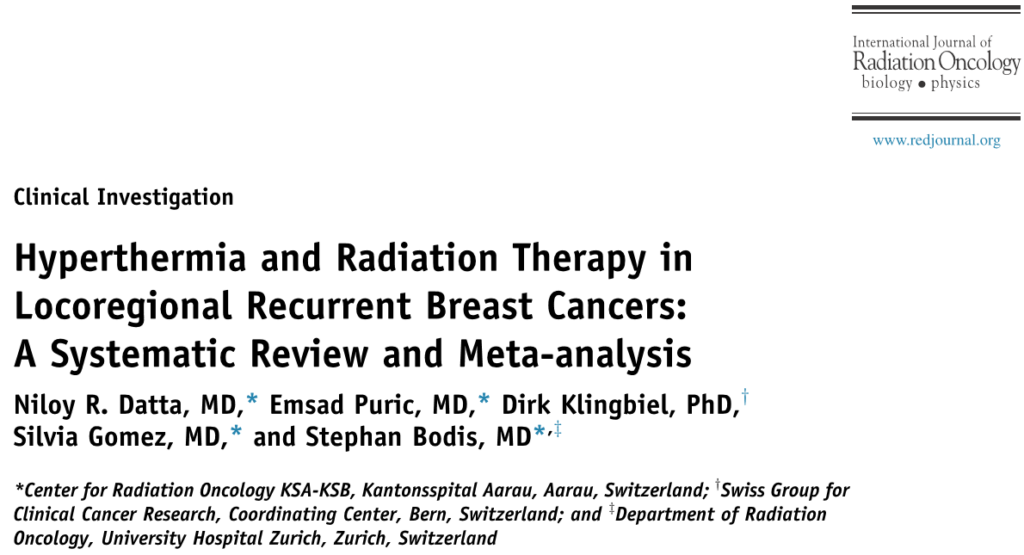Hipertermia i radioterapia w miejscowo nawrotowym raku piersi
tytuł oryg.: Hyperthermia and Radiation Therapy in Locoregional Recurrent Breast Cancers: A Systematic Review and Meta-analysis
Wydawnictwo: Internation Journal of Radiation Oncology
Autor główny: Niloy R. Datta
Pozostali autorzy: Emsad Puric, Dirk Klingbiel, Silvia Gomez, Stephan Bodis
Data: 2015-12-15

DOI: 10.1016/j.ijrobp.2015.12.361
Język publikacji: angielski
Klasa publikacji: Metaanaliza danych klinicznych
Źródła metaanalizy: 34 badania kliniczne:
5 badań dwuramiennych randomizowanych
5 badania dwuramienne nierandomizowane
26 badań jednoramiennych
Liczba pacjentów: 2110
Rodzaj HT: LRHT
Rodzaj HT opis: Hipertermia miejscowa, w większości badań powierzchniowa, fale radiowe
Aparatura: różna (w zależności od publikacji)
Jednostka chorobowa: Miejscowo nawrotowy rak piersi
Symbol Jednostki chorobowej: LRBC
Stage: –
Typ skojarzenia HT stosowany w badaniu: HT+RT
Rodzaj CT: –
Abstract. Purpose: To conduct a systematic review and meta-analysis to evaluate the outcome of hyperthermia (HT) and radiation therapy (RT) in locally recurrent breast cancers (LRBCs).
Methods and Materials: A total of 708 abstracts were screened from 8 databases according to the PRISMA guidelines. Single-arm and 2-arm studies, treating LRBCs with HTand RT but without surgery (for local recurrence) or concurrent chemotherapy were considered. The evaluated endpoint was complete response (CR).
Results: Thirty-one full text articles, pertaining to 34 studies, were shortlisted for the meta-analysis. Eight were 2-arm (randomized, nZ5; nonrandomized, nZ3), whereas 26 were single-arm studies. In all, 627 patients were enrolled in 2-arm and 1483 in single-arm studies. Patients were treated with a median of 7 HT sessions, and an average temperature of 42.5 C was attained. Mean RT dose was 38.2 Gy (range, 26-60 Gy). Hyperthermia was most frequently applied after RT. In the 2-arm studies, a CR of 60.2% was achieved with RT þ HT versus 38.1% with RT alone (odds ratio 2.64, 95% confidence interval [CI] 1.66-4.18, P<.0001). Risk ratio and risk difference were 1.57 (95% CI 1.25-1.96, P<.0001) and 0.22 (95% CI 0.11-0.33, P<.0001), respectively. In 26 single-arm studies, RT þ HT attained a CR of 63.4% (event rate 0.62, 95% CI 0.57-0.66). Moreover, 779 patients had been previously irradiated (696 from single-arm and 83 from 2-arm studies). A CR of 66.6% (event rate 0.64, 95% CI 0.58-0.70) was achieved with HT and reirradiation (mean SD dose: 36.7 7.7 Gy). Mean acute and late grade 3/4 toxicities with RT þ HT were 14.4% and 5.2%, respectively.
Conclusions: Thermoradiation therapy enhances the likelihood of CR rates in LRBCs over RT alone by 22% with minimal acute and late morbidities. For even those previously irradiated, reirradiation with HT provides locoregional control in two-thirds of the patients. Thermoradiation therapy could therefore be considered as an effective and safe palliative treatment option for LRBCs.
Potrzebujesz więcej danych o artykule? Skontaktuj się z PTHO droga mailową.